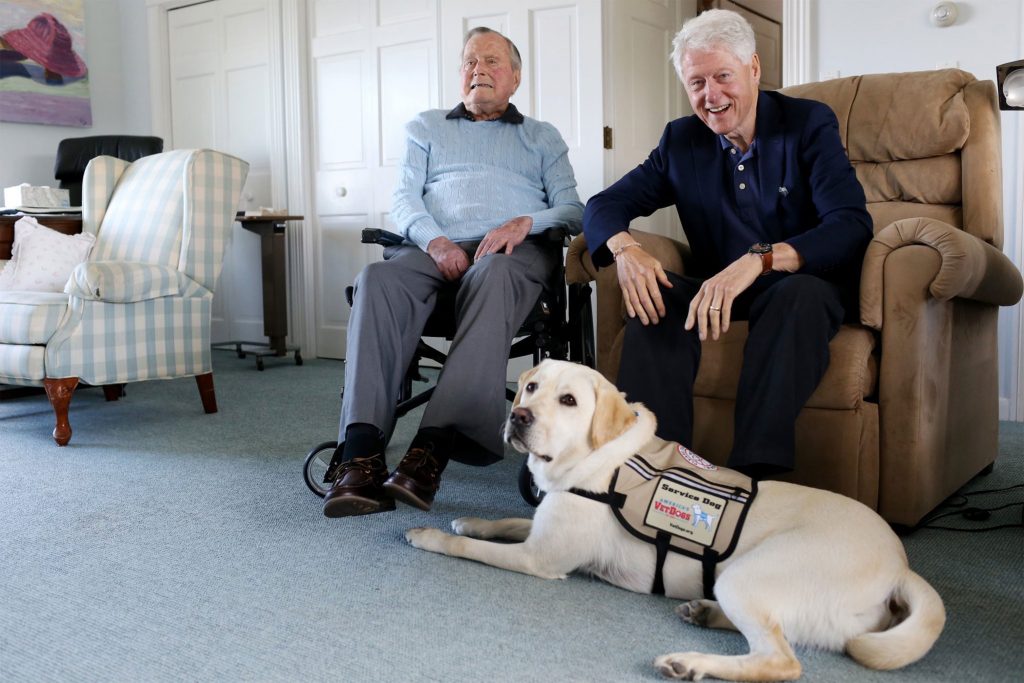Psychiatric service dogs are defined as dogs that are individually trained to perform tasks for people with a mental health disability, which mitigates the problems that occur from the disability, so that the person can attend to any daily tasks and responsibilities. The trained task needs to be directly related to the person’s disability, for example a person may need a dog to alert them to changes in their emotional state and provide an intervention, such as intense nuzzling, banking, fetching an item, etc. If their sole function is to provide comfort just by being present, then the dog does not qualify as a service animal. A few examples of psychiatric service dog tasks might include: medication reminding, alerting you when you are distressed, performing safety checks to alleviate fears for those with PTSD, or intervening during a person’s self-destructive behavior.
*Read more about the differences between an Emotional Support Animal and a Psychiatric Service Dog
What if my dog is still being trained to be a service dog, e.g. a “service dog in-training”?
Service dogs in-training are not considered actual service dogs – they are technically emotional support animals. Once the dog is fully trained, they can transition from being an ESA/PSA in-training, to being a fully trained psychiatric service dog (PSA). Once the dog is fully trained, a letter can be issued stating your dog is a service dog, and how the animal assists you as a service dog.
What is the PSA allowed that is different from the ESA?
Simply put, PSA’s are allowed most places (public places, housing, airplane, hotels…), whereas ESA’s are designed for allowing the animal to live with you in rental housing (and sometimes hotels). From a legal point of view, it is important that you don’t cross that boundary of saying your ESA is a psychiatric service animal unless you have specialized dog training and documentation from a licensed healthcare provider stating that the PSA is necessary, with details about how the animal helps your disability.
How do I train my service dog?
The ADA allows individuals to train their own dog. If hiring trainers is outside your ability to pay, you still have the option to figure out how to train the animal yourself. Even if you hire a trainer, it would still be necessary that you learn about training your animals as a service dog in order to continually reinforce the dog’s skills over time.
Whether you hire a dog trainer, or train your dog yourself, learn as much as you can ahead of time about the types of skills you believe may help reduce any psychiatric disability concerns. I’m certainly able to help you figure out the types of needed training from a disability point of view. If you decide to work with a dog trainer, you will need to collaborate with the trainer on the types of skills needed to assist your disability. If you want to train the dog yourself, there are many practical books and YouTube videos on how to train a psychiatric service dog.
Video Examples for Training for Anxiety, PTSD, Emotional Regulation, Autism Spectrum Disorder
Will my dog need any other training besides addressing a psychiatric need?
Because your service dog may go into public places where dogs are not typically allowed, I highly recommend that your dog also pass a Canine Good Citizen (CGC) test. The CGC is an assessment of how your dog behaves in public places. A CGC evaluator would observe if the dog is well cared for, can walk on a leash, accept friendly strangers, can navigate crowds, perform basic commands, behave politely around other dogs, and handle outside distractions. You can get the animal professionally evaluated, or train the animal yourself using the CGC test as a guideline. Be sure to read up on what the CGC evaluation looks like. You can also read more here about CGC Tests for a service dog.
What else do I need to know?
Most people have Emotional Support Animal, rather than a Psychiatric Service Dog. If you feel you are more suited for a Psychiatric Service Dog, you and your dog need to meets the following criteria:
- You meet the psychiatric need for a Psychiatric Service Dogs (PSA)
- You have extensive knowledge about how Psychiatric Service Dogs (PSA) are different than Emotional Support Animals (ESA)
- Your dog must be at least 1 yr old
- Your dog must behave extremely well in public (refer to CGC training)
- Your dog is specially trained to perform a task that addresses your disability needs *
* NOTE: Your dog must be able to perform a task that is above and beyond what dogs do normally. For example, asking the dog to sit on your lap to help calm you is what dogs do without training, and in this case, your dog would be considered an emotional support animal, not a service animal. Consider how your dog is specially trained beyond what dogs do normally. This interrupting harmful behavior video or this deep pressure therapy video provide two examples.
Are there any legal concerns I need to be aware of?
One final note of caution – it is important that your psychiatric service dog has these three goals completed: 1) a letter from a licensed mental health provider (not older than 12 months), 2) the animal is fully trained to perform the tasks needed for the disability, and 3) the animal behaves well in public (i.e. CGC skills). Falsely claiming that a dog is a service dog will lead to legal problems. In Texas, claiming that your dog is a service animal (when it is not) is a misdemeanor, with a fine of up to $1000 and 30 hours of community service. If you apply due diligence to the training of your animal and documentation of psychiatric need, you and your dog should be legally protected as a psychiatric service dog in most public and private places.

Sully H. W. Bush
More examples of Psychiatric Service Dog Tasks
Psychiatric Service Dogs assist handlers who have a mental illness or psychiatric disability, and are often cross trained for other specialties. You can read more here and see the examples below.
- Provide Medication Reminders
- Lay Across Handler to Provide Deep Pressure Therapy During Panic Attacks
- Provide Tactile Grounding Via Nuzzling or Licking
- Provide a Buffer between the Handler and the Public
- Apply Gentle Teeth Pressure to Forearm to Interrupt Dissociative Episode
- Alert Handler to Episodes of Strong Emotion
- Interrupt Repetitive Self Harm
- Retrieve Self Care Kit
- Wake Up during Nightmares
- Interrupt Flashbacks
- Search House
- Provide “Reality Check” so Handler Can Verify Hallucinations Are Not Present
- Stabilize Handler’s Routine
- Lead the Handler Home
Read more about the Differences between an ESA and PSA here



